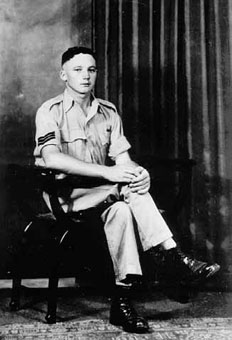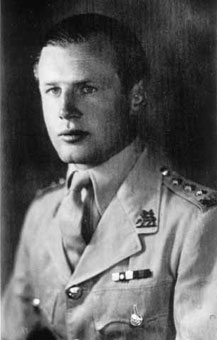The Middle East
2nd Queen’s Open The Batting
Chapter 1
At the outbreak of the 1939-45 War 2nd Queen’s was organised on a three rifle companies basis, equipped purely for anti-terrorist operations in Palestine. The battalion strength was 24 officers and 512 other ranks.
By the end of September 1939 the leaders of both Arab and Jewish communities had pledged loyalty to the common cause, and terrorist incidents had virtually ceased. A few rebels continued to be rounded up or shot sporadically, and strategic points continued to be garrisoned, but the emphasis shifted towards building up the forces to a war establishment. This entailed not only reinforcement but re-equipment, reorganisation, and, most importantly, retraining.
Battalions were taken out in rotation for retraining. 2nd Queen’s acted as one of the holding battalions during this period, taking over Nablus Fort from The Rifle Brigade and Jerusalem from The Black Watch in addition to maintaining their own base at Tulkarm. It was not until the 8th November that they themselves were withdrawn for retraining to Nathanya on the coast. By then two large drafts had arrived and the battalion strength was over 700. ‘D’ Company was resuscitated. Unfortunately there were correspondingly voracious demands to fill new staff and extra-regimentally employed appointments which resulted in the officer strength being reduced to fourteen.

Jericho Camp, the best camp the Col had ever seen!
In January 1940 the 2nd Queen’s were sent to Jericho to join a new brigade, the 16th Infantry Brigade, commanded by Brigadier C.E.N. Lomax, DSO, MC. Their erstwhile sister battalions of 14 Brigade, 2nd Leicesters and 1st Argylls, also joined 16 Brigade. Thus 2nd Queen’s celebrated its first anniversary in Palestine 700 feet below sea level and 30 miles from Jerusalem in a delightful climate and surroundings. It had suffered extremely light casualties and earned itself a high reputation. It had carried out the astonishing total of 258 operations. Its total casualties had been one officer killed (Major George Beeton during the operation at Abu Salami), two officers wounded (2/Lts Gordon Reinhold and Michael Forrester), one sergeant (Sgt Golding) and five other ranks wounded. Four other ranks had also died in hospital under medical care. Awards for gallantry had included one DSO, four MCs, one DCM, five MMs and eight mentions in despatches.
|
|
|
| Sgt Tommy Atkins, MT Sgt 1941 |
Capt Michael Forrester, MC Cairo, 1941 |
At the end of March the Brigade moved to Latrun in the coastal plain between Jerusalem and Jaffa; and on the 1st April Lt-Col Ross relinquished command of 2nd Queen’s to Major B.C. Haggard. Lt-Col Ross received command of a brigade and later became GOC 53rd (Welsh) Division in the UK and NW Europe from 1942-45.
With the fall of France and the entry into the war of Italy as Germany’s ally in June 1940, the Middle East became the main theatre of war. In early September the Italian Tenth Army invaded Egypt from its bases in Cyrenaica by advancing eastward along the coast road through Sollum and Buq Buq to capture Sidi Barrani. There it paused to reorganise for a further advance on Alexandria and the Delta of the Nile. Opposing this advance of five divisions was the 7th Armoured Division, and some detached units including the 11th Hussars, a French Motor Marine Company, two batteries of the Royal Horse Artillery, 3rd Coldstream Guards and machine gun companies of 1st Northumberland Fusiliers. The reserve division was the 4th Indian Division less one of its infantry brigades, which had not arrived in theatre, and a New Zealand brigade.
On the 7th September 16 Brigade was ordered to move to Egypt as a reinforcement. They were not sorry to leave Palestine because it had been depressing for the troops to be acting as a garrison during a period when there was nothing but bad news from all quarters, including the Home Front, which was enduring the Battle of Britain. On arrival in Egypt the Brigade was attached to the 4th Indian Division in order to make it up to a strength of three infantry brigades. Since the other two brigades in the Division were known as the 5th and the 11th Indian Infantry Brigades (each having one British battalion and two Indian battalions) 16 Brigade became known as the 16th British Infantry Brigade, with its three British battalions, and continued under this title for the rest of the campaign.
16 Brigade’s destination was Maaten Baqqush, the location of the ‘Baqqush Box’, a defensive position about 30 miles behind Mersa Matruh and commanding the main road and railway back to Alexandria. The Box was bounded on the north by the sea; 16 Brigade held the western side, 5 indian Brigade the south, and the New Zealanders the east. Within the Box were the Western Desert Force Headquarters (with Lieut-General R.N. O’Connor as GOC), Air Headquarters of No. 202 Group, and a large number of other arms and services. Within 16 Brigade the 2nd Leicesters were on the right by the sea, 2nd Queen’s in the centre astride the road and railway, and 1st Argylls on the left with their left on the high escarpment, which was held by 5 Indian Brigade.
During this period the Italian Regia Aeronautica enjoyed considerable air superiority. The RAF’s fighter, the Gloster Gladiator, was slower than the Italian bombers, so it was hardly surprising that the Baqqush Box was regularly strafed and bombed. The defences were by no means comprehensive, and considerable digging and wiring had to be completed, but by and large the defenders were adequately dug in and the damage was slight. Eventually some Hurricanes and Blenheims arrived, and the Regia Aeronautica practically disappeared from the skies except by night. Besides the work on the defences there were limited opportunities for bathing parties to enjoy the beaches in the area controlled by 2nd Leicesters. There was also some hard training for desert warfare including navigation by sun compass and practice in dispersion until it was automatic that vehicles were more than 200 yards from each other. Much time was spent liaising with Royal Artillery units, especially with 104th Regiment (Essex Yeomanry) RHA. The later exercises were rehearsals of possible operations. Such exercises were instigated because it had been realised that security of information inside Egypt was extremely difficult to achieve since there were many Italian sympathisers, if not actual agents, living in Egypt. Indeed, on the 23rd October a ‘Jock Column’ consisting of men from The Cameron Highlanders and tanks of the 8th Hussars was severely repulsed when raiding the Italian camp at Maktila, only to find the entire Marmarica Division standing-to and waiting for them. This was traced directly to café gossip in Cairo, where the raid had been discussed with unusual accuracy some three days previously.
At the beginning of December preparatory instructions for such an exercise were received, followed by a warning order on the 4th, that the 4th Indian Division would assemble on the 6th in an area west of the Siwa road. On the 5th December the 16th British Infantry Brigade moved out in readiness to the top of the escarpment. As soon as the Brigade was in the desert and out of touch with possible spies, a brigade operation order was issued which stated: “The Brigade will move forward to an assembly area and be prepared to take offensive action against the enemy wherever met.”
« Previous ![]() Back to List
Back to List ![]() Next »
Next »
Related


